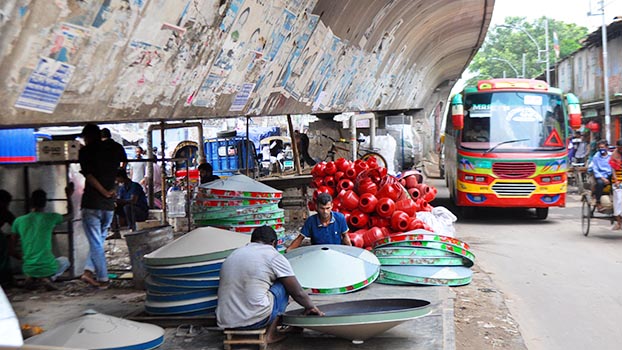Open spaces beneath city flyovers misused


Dhaka is home to 7 flyovers spanned over 29 kilometers. However, the scenes underneath the elevated roads are not appealing to say the least.
The flyovers of Mohakhali, Khilgaon, Tejgaon, Banani, Kuril, Jatrabari and Mogbazar share similar scenarios on their ground levels. Spaces underneath the flyovers are occupied by rows of illegal stalls, horse stables or dumps of garbage. The spaces also serve as homes for the homeless or in some cases, just left empty, dirty and unattended.
Many of the uncared left over spaces become shelter for drug addicts and zones for other illegal activities due to its lack of care.
Scenes under the Mohakhali flyover contain lanes of tea stalls and other small shops. Small traders illegally occupy parts of the area from time to time.
The space under the Khilgaon flyover is widely occupied by horses used for entertainment purposes. Due to this, the area remains unhygienic and dirty.
Experts believe that this unattended space has immense amount of potential. Flyovers in many other countries can serve as examples. In many countries, the bottoms of the flyovers can be seen as small markets, restaurants or even nature parks.
Adil Mohammad Khan, secretary general of Bangladesh Institute of Planners told Bangladesh Post that the capital is lacking space for the community. These spaces under the flyovers can fill that void to some extent.
“The concern bodies should redesign the spaces as per the need of the people. They can make commercial plans but it would be better if they incorporate with the community and decide what is needed in that area,” he said.
He added that internationally, these spaces are used as small parks. Even the pillars are sometimes designed and filled with greenery.
Urban planner Professor Nazrul Islam told Bangladesh Post that when a flyover is designed and constructed, the concerned parties should also keep the spaces underneath in consideration. The same initiative will not work for all the flyovers because of how and where they are built.
“If an initiative is taken for the space under Kuril flyover, the same cannot be done for the space under Mohakhali flyover. The flyovers are under the guidance of different bodies such as the city corporations or RAJUK. Their planners need to take initiatives individually,” he said.
Architect Iqbal Habib told Bangladesh Post that the flyovers are built on the land that belongs to the public. Hence, the lands under the flyovers need to be put to use for the public in some way.
“The space belongs to the public. Initiatives need to be taken to be put it to public use. The space could be converted into libraries, rented hawker markets or even cafes. The least it could be is a clean open space for the public to play or to stroll upon,” he said.
He further said that the government could open it up to private sponsorships and let them make the best use of the space. It will eventually serve the people.
According to sources, Dhaka South City Corporation (DSCC) manages three flyovers: Moghbazar-Mouchak Flyover, Khilgaon Flyover and Mayor Mohammad Hanif Flyover.
With 11 kilometers of approximate length, Mohammad Hanif Flyover of the capital is the longest flyover in Bangladesh. However, a major portion under the iconic figure is filled with garbage dumped by nearby store and houses.
DSCC Mayor Barrister Sheikh Fazle Noor Taposh recently said that illegally occupied lands under the flyovers inside the city corporation's jurisdiction will be vacated in phases.
"The spaces under the flyovers are heavily occupied, mismanaged and filled with garbage. Different quarters are currently occupying these areas. We will free up and recover these spaces in turns so that vehicles can move freely under the flyovers as well as create an open and airy environment," he said.
Chairman of Rajdhani Unnayan Kartripakkha (RAJUK), ABM Amin Ullah Nuri told Bangladesh Post that the RAJUK built Kuril Flyover has been handed over to Road Transport and Highways Division recently for management.
Officials of Road Transport and Highways Division could not be reached for comments on the matter when contacted by the correspondent of Bangladesh Post.
Chief Engineer of DNCC Brigadier General Muhammad Amirul Islam told Bangladesh Post that he is unable to comment due to restrictions. He recommended contacting the DNCC mayor for the update.
The statement of the DNCC mayor Atiqul Islam regarding this issue could not be obtained as he did not receive phone calls when contacted.


